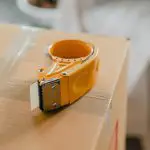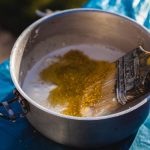Are you struggling to remove adhesive from your cotton fabric? Don’t worry, we’ve got you covered!
In this article, we will guide you through the process of removing adhesive using simple and effective methods.
Whether you need to remove glue, tape residue, or any other sticky substance, we will provide you with step-by-step instructions.
Get ready to say goodbye to those stubborn adhesive stains and restore your cotton fabric to its pristine condition.
Let’s dive in!
Table of Contents
Types of Adhesive to Remove From Cotton Fabric
To remove adhesive from cotton fabric, you’ll need to know the types of adhesive commonly found on it. Adhesive can be found on cotton fabric from labels, stickers, or even glue accidents.
The most common type of adhesive found on cotton fabric is water-based adhesive. This type of adhesive is typically used for labels and stickers and can be easily removed by soaking the fabric in warm soapy water and gently rubbing the adhesive off.
Another type of adhesive commonly found on cotton fabric is solvent-based adhesive. This type of adhesive is stronger and more difficult to remove. It is often used in industrial settings or for heavy-duty applications. To remove solvent-based adhesive from cotton fabric, you can try using a solvent like rubbing alcohol or acetone. Apply the solvent to a clean cloth and gently dab the adhesive until it loosens and can be wiped away.
If you are unsure about how to safely remove adhesive from your cotton fabric or if the adhesive is particularly stubborn, it may be best to seek professional adhesive removal services. These professionals have the expertise and specialized tools to safely and effectively remove adhesive without damaging the fabric.
Preparing the Cotton Fabric for Adhesive Removal
Before starting, make sure you’ve gathered all the necessary materials for preparing the cotton fabric. This step is crucial in ensuring the best outcome when removing adhesive from your fabric. Here’s what you need to do to prepare your cotton fabric:
-
Pre-treating fabric:
-
Start by gently scraping off any excess adhesive from the fabric using a plastic scraper or your fingernail. Be careful not to damage the fabric.
-
Next, apply a small amount of rubbing alcohol or acetone to a clean cloth and gently dab the adhesive stain. This will help loosen the adhesive and make it easier to remove.
-
Testing on a small area:
-
It’s important to test any cleaning solution or adhesive remover on a small, inconspicuous area of the fabric before applying it to the entire stain. This will help you determine if the solution is safe to use and won’t cause any damage or discoloration to the fabric.
-
Proceed with caution:
-
Once you have pre-treated the fabric and tested the cleaning solution, you can proceed with removing the adhesive. Follow the instructions on the adhesive remover product carefully, ensuring that you don’t oversaturate the fabric or scrub too harshly.
Using Heat to Remove Adhesive From Cotton Fabric
Using heat is a popular method for getting rid of adhesive stains on cotton fabric. One effective way to remove adhesive from cotton fabric is by using steam.
The heat from the steam helps to loosen the adhesive, making it easier to remove. To do this, fill a steam iron with water and set it to the appropriate temperature for cotton fabric.
Place a clean cloth over the adhesive stain to protect the fabric and then hold the steam iron a few inches above the cloth. Press the steam button and move the iron in a circular motion over the adhesive stain.
The heat and steam will gradually soften the adhesive, allowing it to release from the fabric. Once the adhesive has loosened, use a clean cloth to gently blot and lift the adhesive off the fabric. Be careful not to rub too vigorously, as this could damage the fabric.
Repeat the process if necessary until all the adhesive is removed. Remember to always follow the manufacturer’s instructions for your steam iron and use caution when working with heat.
Removing Adhesive With Solvents or Chemicals
When it comes to removing adhesive from fabric, it’s important to choose safe solvents that won’t damage or discolor the material. Look for solvents specifically designed for use on fabric and follow the instructions carefully.
Additionally, take steps to prevent chemical residue from remaining on the fabric by thoroughly rinsing and washing it after using the solvent.
Safe Solvents for Fabric
There’s no need to worry about damaging your cotton fabric when using safe solvents. These solvents are designed to effectively remove adhesive without causing harm to the fabric.
Here are some environmentally friendly alternatives to consider:
-
Citrus-based solvents: These solvents are made from natural citrus extracts and are known for their strong adhesive removing properties.
-
Vinegar: A common household ingredient, vinegar can also be used to remove adhesive from cotton fabric. Its acidic nature helps break down the adhesive bonds.
-
Rubbing alcohol: This solvent is effective in removing adhesive residue from cotton fabric. It evaporates quickly, leaving behind a clean surface.
When using safe solvents, it is important to follow the instructions provided and test them on a small, hidden area of the fabric first to ensure compatibility. Always ventilate the area properly and wear protective gloves when handling solvents.
Chemical Residue Prevention
To prevent chemical residue on your fabric, it’s important to properly ventilate the area and wear protective gloves when handling solvents. Chemical residue can be harmful to your health and can also damage your fabric.
When using solvents, make sure to work in a well-ventilated space to avoid inhaling any fumes. Additionally, wearing protective gloves will help prevent any direct contact with the solvents, reducing the risk of skin irritation or burns.
If you’re concerned about the environmental impact of solvents, there are eco-friendly alternatives available. These alternatives are made from natural ingredients and are less harmful to both your health and the environment.
When choosing a solvent or alternative, always read the instructions carefully and test it on a small, inconspicuous area of your fabric before proceeding with the whole cleaning process.
Natural Remedies to Remove Adhesive From Cotton Fabric
If you’re looking for natural remedies to remove adhesive from cotton fabric, there are a few key methods you can try.
First, you can use a mixture of lemon juice and vinegar to break down the adhesive.
Another option is to create a baking soda paste by combining baking soda with water, which can help loosen the adhesive.
Lastly, you can try freezing the fabric and then scraping off the adhesive with a blunt tool.
Lemon Juice and Vinegar
Lemon juice and vinegar can be effective in removing adhesive from cotton fabric. Here are some tips to help you effectively use these ingredients:
-
Lemon Juice Alternatives:
-
White vinegar: If you don’t have lemon juice on hand, white vinegar can be a great substitute. Its acidic properties help break down the adhesive.
-
Citric acid solution: Mixing citric acid with water can create a powerful adhesive remover that is similar to lemon juice.
-
Essential oils: Some essential oils, such as tea tree oil or eucalyptus oil, have adhesive-dissolving properties and can be used as alternatives.
-
Vinegar Application Techniques:
-
Soaking: Dilute vinegar with water and soak the adhesive-stained cotton fabric for a few minutes before gently scrubbing with a soft brush.
-
Spraying: Fill a spray bottle with vinegar and water, then spray the adhesive area. Let it sit for a few minutes before wiping away the residue.
-
Pre-treatment: Apply vinegar directly to the adhesive spot and let it sit for a few minutes before washing the cotton fabric as usual.
Remember to always test these methods on a small, inconspicuous area of the fabric before treating the adhesive stain.
Baking Soda Paste
Baking soda mixed with water creates a paste that can effectively dissolve sticky residue.
To remove adhesive from cotton fabric, start by mixing equal parts of baking soda and water to form a thick paste. Apply the paste directly to the sticky residue and let it sit for about 10 minutes.
Then, use a soft cloth or sponge to gently scrub the area in circular motions. The baking soda acts as a mild abrasive, helping to break down the adhesive without damaging the fabric.
Rinse the area with warm water and pat it dry. If baking soda is not available, there are alternative fabric-safe solvents that can be used, such as rubbing alcohol or coconut oil.
However, always test these alternatives on a small, inconspicuous area of the fabric before applying them to the sticky residue.
Freezing and Scraping
To effectively remove sticky residue, you can try freezing the area and then gently scraping it off with a tool like a credit card. Freezing the adhesive helps to harden it, making it easier to scrape off without damaging the fabric.
Here are some alternative methods you can try:
-
Use ice cubes: Place a few ice cubes in a plastic bag and place it over the sticky residue. Leave it for a few minutes to freeze the adhesive, then scrape it off.
-
Rubbing alcohol: Dampen a cloth with rubbing alcohol and dab it onto the sticky area. Let it sit for a few minutes, then gently scrape off the residue.
-
Warm water and dish soap: Mix warm water with a few drops of dish soap. Soak the affected area for a few minutes, then scrape off the residue.
Remember to always test these methods on a small, inconspicuous area of the fabric before applying them to the entire stain.
Scraping or Peeling Adhesive off Cotton Fabric
Use a credit card or your fingernail to gently scrape off the adhesive from the cotton fabric. This scraping method is an effective way to remove adhesive residue without causing damage to the fabric. Start by applying light pressure and work in small, controlled motions to avoid tearing or stretching the fabric. If the adhesive is particularly stubborn, you can try using a plastic scraper or an old toothbrush to gently scrape away the residue. Be cautious not to use excessive force, as this may push the adhesive deeper into the fabric fibers.
Alternatively, you can try the peeling method to remove adhesive from cotton fabric. Begin by locating an edge or corner of the adhesive and carefully peel it away from the fabric. Use slow and steady movements to avoid ripping the fabric. If the adhesive is resistant, you can warm it up using a hairdryer on a low heat setting. The heat will soften the adhesive, making it easier to peel off. Remember to always test the heat on a small, inconspicuous area before applying it to the adhesive.
Whether you choose the scraping or peeling method, it is important to be patient and take your time to prevent any damage to the cotton fabric.
Washing and Drying Cotton Fabric After Adhesive Removal
After you have successfully removed the adhesive residue from your cotton fabric, it is essential to wash and dry it properly to maintain its quality. Here are some tips to ensure your cotton fabric remains in good condition:
-
Washing techniques:
-
Use a gentle detergent: Opt for a mild detergent that is suitable for delicate fabrics like cotton. Harsh detergents can damage the fabric and affect its color.
-
Hand wash or machine wash: Depending on the specific instructions for your fabric, you can choose to hand wash or machine wash. If machine washing, use a delicate or gentle cycle.
-
Avoid hot water: Hot water can shrink or distort cotton fabric, so it’s best to wash it in cool or lukewarm water.
-
Air drying:
-
Hang it up: After washing, hang your cotton fabric to dry instead of using a dryer. This will prevent any potential shrinkage and help maintain the fabric’s shape.
-
Avoid direct sunlight: While drying, keep your fabric away from direct sunlight as it can fade the colors.
-
Use a clothesline or drying rack: Choose a well-ventilated area to hang your fabric, allowing air to circulate and aid in the drying process.
Preventing Adhesive Stains on Cotton Fabric
Preventing adhesive stains on cotton fabric can be achieved by following proper removal techniques and taking precautions during application. By being aware of the potential for adhesive residue and taking steps to prevent it, you can keep your cotton fabric looking clean and stain-free.
One way to prevent adhesive stains on cotton fabric is to choose the right adhesive for the job. Some adhesives are specifically formulated to be removable or have low residue, making them less likely to leave behind stains. Additionally, applying the adhesive sparingly and evenly can help minimize the chances of excess residue.
Another important step in preventing adhesive stains is to protect the fabric during application. Placing a barrier, such as wax paper or plastic wrap, between the fabric and the adhesive can help prevent direct contact and reduce the chances of staining. It is also important to follow the manufacturer’s instructions for application and removal to minimize the risk of residue.
To summarize the prevention techniques for adhesive stains on cotton fabric, refer to the table below:
| Prevention Techniques | Tips for Success |
|---|---|
| Choose the right adhesive | Look for removability or low residue formulations |
| Apply adhesive sparingly | Use just enough to get the job done |
| Use a barrier during application | Wax paper or plastic wrap can protect the fabric |
| Follow manufacturer’s instructions | Proper application and removal techniques |
Conclusion
To conclude, removing adhesive from cotton fabric can be done using various methods. These methods include applying heat, using solvents, trying natural remedies, scraping, or washing. It is important to choose the right method based on the type of adhesive and fabric.
By preparing the fabric and using the appropriate technique, you can successfully remove adhesive stains from cotton fabric. It is also important to take precautions during the process.
Remember to always follow the instructions carefully and test any chemicals or solvents on a small, inconspicuous area before proceeding with the removal process.
- The Use of Nonwovens in Construction and Civil Engineering - July 11, 2025
- The Use of Nonwovens in Construction and Civil Engineering - July 11, 2025
- The Use of Nonwovens in Construction and Civil Engineering - July 11, 2025





